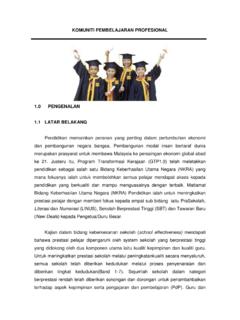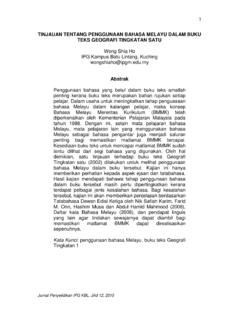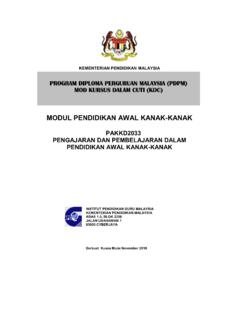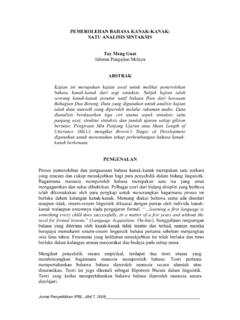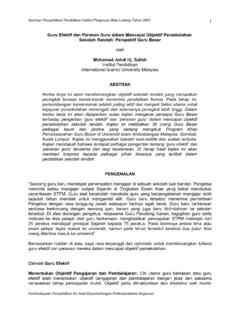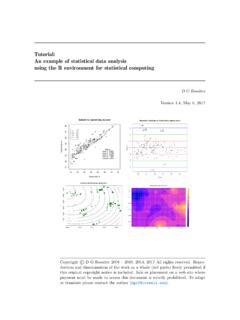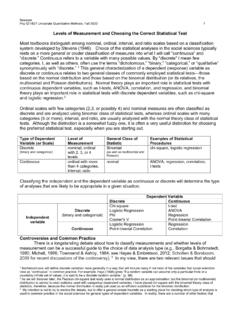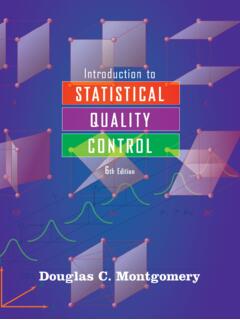Transcription of Sample Size Estimation Using Cohen Statistical Power …
1 Sample size Estimation Using KREJCIE AND MORGAN AND. Cohen Statistical Power ANALYSIS: A COMPARISON. Chua Lee Chuan Jabatan Penyelidikan ABSTRACT. In most situations, researchers do not have access to an entire Statistical population of interest partly because it is too expensive and time consuming to cover a large population or due to the difficulty to get the cooperation from the entire population to participate in the study. As a result, researchers normally resort to making important decisions about a population based on a representative Sample . Hence, estimating an appropriate sampling size is a very important aspect of a research design to allow the researcher to make inferences from the Sample statistics to the Statistical population.
2 The Power of a Sample survey lies in the ability to estimate an appropriate Sample size to obtain the necessary data to describe the characteristics of the population. With that as the rationale, this article was written to make comparison between two commonly used approaches in estimating sampling size : Krejcie and Morgan and Cohen Statistical Power Analysis. It also highlights the significance of Using Cohen 's formula over Krejcie and Morgan's for higher accuracy to base decisions on research findings with confidence. INTRODUCTION. For most studies that require data from a wide and diverse population size , rarely do researchers cover the whole population. The normal practice is to draw a Sample from the target population.
3 Salant and Dillman (1994) defined a Sample as a set of respondents selected from a larger population for the purpose of a survey. The main reason to Sample is to save time and money. Furthermore, it is generally not necessary to study all possible cases to understand the phenomenon under consideration (Ary, Jacobs, & Razavieh, 1996). The most important thing taken into consideration is that the Sample drawn from the population must be representative so that it allowed the researcher to make inferences or generalisation from the Sample statistics to the population understudied (Maleske, 1995). If the Sample size is too low, it lacks precision to provide reliable answers to research questions investigated.
4 If the Sample size is too large, time and resources could be wasted often for minimal gain. Therefore, the Power of a Sample survey actually lied in the Jurnal Penyelidikan IPBL, Jilid 7, 2006_____. 79. ability to obtain the necessary information from a relatively few respondents to describe the characteristics of the entire population. DETERMINING THE Sample size . For any research, the Sample size of any study must be determined during the designing stage of the study. However, before determining the size of the Sample that needed to be drawn from the population, a few factors must be taken into consideration. According to Salant and Dillman (1994), the size of the Sample is determined by four factors: (1) how much sampling error can be tolerated; (2).
5 Population size ; (3) how varied the population is with respect to the characteristics of interest; and (4) the smallest subgroup within the Sample for which estimates are needed. Using the above methods as a guideline, the following section aims to compare two approaches in determining the Sample size of a population of 500 people Using (a). Krejcie and Morgan (1970) and (b) Cohen Statistical Power Analysis. Krejcie and Morgan Estimation of Sample size in research Using Krejcie and Morgan is a commonly employed method. Krejcie and Morgan (1970) used the following formula to determine sampling size : S = X2NP (1-P)/ d2 (N-1) + X2P(1-P). S = required Sample size X2 = the table value of chi-square for one degree of freedom at the desired confidence level N = the population size P = the population proportion (assumed to be.)
6 50 since this would provide the maximum Sample size ). d = the degree of accuracy expressed as a proportion (.05). Based on Krejcie and Morgan's (1970) table for determining Sample size , for a given population of 500, a Sample size of 217 would be needed to represent a cross- section of the population. However, it is important for a researcher to consider whether the Sample size is adequate to provide enough accuracy to base decisions on the findings with confidence. Therefore, in order to find out if the Sample size recommended by Krejcie and Morgan (1970) is sufficient, the next section aims to illustrate the Estimation of sampling size Using Cohen 's (1988) Statistical Power analysis. Jurnal Penyelidikan IPBL, Jilid 7, 2006_____.
7 80. Cohen Statistical Power Analysis According to Cappelleri and Darlington, (1994), Cohen Statistical Power Analysis is one of the most popular approaches in the behavioural sciences in calculating the required sampling size . According to Cohen (1998), in order to perform a Statistical Power analysis, five factors need to be taken into consideration: 1. significance level or criterion 2. effect size 3. desired Power 4. estimated variance 5. Sample size Cohen (1988) Statistical Power analysis exploits the relationships among the five factors involved in Statistical inferences. For any Statistical model, these relationships are such that each is a function of the other four. Taking that into consideration, it means that if Sample size is to be determined, it can be estimated for any given Statistical test by specifying values for the other four factors: (1).
8 Significance level, (2) effect size , (3) desired Power and (4) estimated variance. When Cohen 's Statistical Power analysis is used to determine the Sample size , the objective of the analysis is to calculate an adequate sampling size so as to optimise as opposed to maximising sampling effort within the constraint of time and money. Optimising sampling efforts will avoid situations where lack of subjects is considered giving rise to inconclusive inference-making. Contrary, maximising sampling efforts occur when the collection of data goes beyond the required level to achieving significant results, thereby, limited resources are wasted. In order to determine an adequate Sample size , the values of significance level, effect size , Power and estimated variance have to be pre-determined.
9 The Statistical level of significance for most studies in the teaching field is often fixed at alpha = .05. Alpha is the probability of wrongly rejecting the null hypothesis, thus committing Type I error. Assigning a less stringent alpha would increase the risk of false rejection or crying wolf' (Eagle, 1999), casting doubts on the validity of the results. However, if the alpha is too conservative, evidence from the findings might fail to reject the null hypothesis in the presence of substantial population effect. Therefore, setting the alpha at .05, is considered the most conventional level of significance, which is normally used in the field of education. (Ary, et al., 1996). The next factor to be determined is the effect size .
10 Effect size generally means the degree to which the phenomenon is present in the population or the degree to which the null hypothesis is false ( Cohen , 1988). It essentially measures the distance or discrepancy between the null hypothesis and a specified value of the alternative hypothesis. Each Statistical test has its own effect size index. All the indexes are scale free and continuous ranging from zero upwards ( Cohen , 1992). For any Jurnal Penyelidikan IPBL, Jilid 7, 2006_____. 81. Statistical test, the null hypothesis has an effect size of zero. For example, in Using the product-moment correlation to test a Sample for significance, the effect size index is r, and H0 posits that r = 0. For multiple regression, the effect size index is f2.


